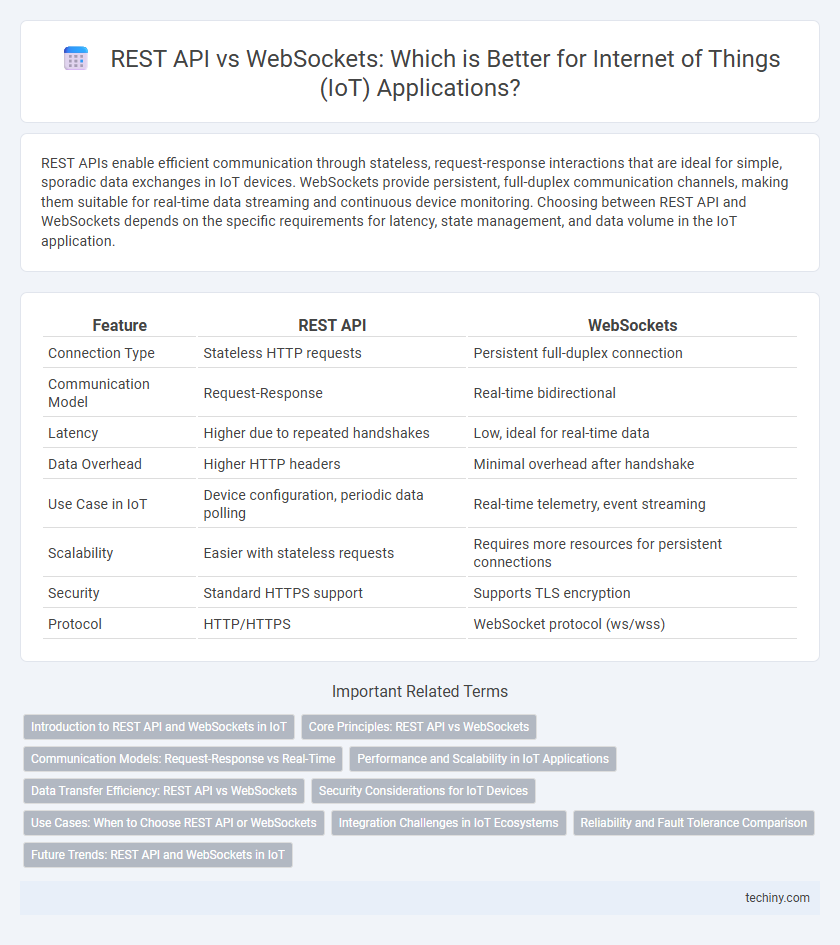REST APIs enable efficient communication through stateless, request-response interactions that are ideal for simple, sporadic data exchanges in IoT devices. WebSockets provide persistent, full-duplex communication channels, making them suitable for real-time data streaming and continuous device monitoring. Choosing between REST API and WebSockets depends on the specific requirements for latency, state management, and data volume in the IoT application.
Table of Comparison
| Feature | REST API | WebSockets |
|---|---|---|
| Connection Type | Stateless HTTP requests | Persistent full-duplex connection |
| Communication Model | Request-Response | Real-time bidirectional |
| Latency | Higher due to repeated handshakes | Low, ideal for real-time data |
| Data Overhead | Higher HTTP headers | Minimal overhead after handshake |
| Use Case in IoT | Device configuration, periodic data polling | Real-time telemetry, event streaming |
| Scalability | Easier with stateless requests | Requires more resources for persistent connections |
| Security | Standard HTTPS support | Supports TLS encryption |
| Protocol | HTTP/HTTPS | WebSocket protocol (ws/wss) |
Introduction to REST API and WebSockets in IoT
REST API enables IoT devices to communicate using stateless HTTP requests, facilitating easy integration and scalability through standard methods like GET, POST, and PUT. WebSockets provide a full-duplex communication channel over a single TCP connection, enabling real-time data exchange critical for responsive IoT applications such as smart home systems and industrial monitoring. Choosing between REST API and WebSockets depends on the specific IoT use case requirements, including latency, bandwidth, and response time.
Core Principles: REST API vs WebSockets
REST API relies on stateless client-server communication, using standard HTTP methods to perform CRUD operations, making it ideal for request-response scenarios in IoT. WebSockets establish a persistent, full-duplex connection between client and server, enabling real-time, low-latency data exchange crucial for continuous sensor data streaming and device control. The core principle difference lies in REST's statelessness and scalability versus WebSockets' stateful, event-driven interaction model optimized for instant communication.
Communication Models: Request-Response vs Real-Time
REST API communication models operate on a request-response basis, where clients initiate requests and servers provide immediate responses, making it ideal for stateless, infrequent data exchanges in IoT devices. WebSockets enable full-duplex, real-time communication by maintaining a persistent connection between client and server, supporting continuous data streams and instantaneous updates critical for IoT applications requiring low latency. The choice between REST API and WebSockets depends on specific IoT use cases, balancing factors like network overhead, response latency, and data transmission frequency.
Performance and Scalability in IoT Applications
REST APIs offer simplicity and statelessness, making them ideal for IoT applications with sporadic data requests and limited device resources. WebSockets provide persistent, full-duplex communication channels, enabling low-latency data transfer and better performance in real-time IoT scenarios with high-frequency device interactions. Scalability favors WebSockets in dense IoT networks due to reduced overhead and more efficient resource utilization compared to REST's repeated HTTP connections.
Data Transfer Efficiency: REST API vs WebSockets
REST APIs rely on stateless HTTP requests, resulting in higher overhead and increased latency for frequent data transfers in IoT environments. WebSockets maintain persistent connections, enabling real-time, bidirectional communication with minimal protocol overhead, enhancing data transfer efficiency. For IoT applications requiring continuous data streams and low latency, WebSockets offer superior performance compared to REST APIs.
Security Considerations for IoT Devices
REST APIs in IoT devices offer stateless communication that simplifies authentication and authorization using token-based methods like OAuth 2.0, enhancing device security. WebSockets enable real-time bidirectional communication but require continuous security measures such as TLS encryption and stringent origin validation to prevent data interception and unauthorized access. Ensuring robust security in IoT applications involves combining encrypted protocols, effective key management, and implementing secure authentication mechanisms tailored to each communication method's characteristics.
Use Cases: When to Choose REST API or WebSockets
REST API suits IoT applications requiring stateless communication, such as device configuration, data retrieval, and command execution where low-frequency, request-response interaction is sufficient. WebSockets excel in scenarios demanding real-time bidirectional communication, like live sensor data streaming, continuous monitoring, and instant control feedback for smart home systems or industrial automation. Choosing REST API or WebSockets depends on the need for either synchronous request-response efficiency or persistent low-latency connectivity in IoT environments.
Integration Challenges in IoT Ecosystems
REST APIs in IoT ecosystems face integration challenges such as stateless communication and higher latency, limiting real-time device interaction. WebSockets alleviate these issues by enabling full-duplex, persistent connections, which support instantaneous data exchange but require more complex connection management and security considerations. Balancing the scalability of REST with the real-time capabilities of WebSockets is critical for seamless IoT integration and efficient device communication.
Reliability and Fault Tolerance Comparison
REST APIs provide reliable, stateless communication by utilizing HTTP protocols that ensure each request is independent, simplifying error recovery and fault tolerance in IoT systems. WebSockets enable continuous, full-duplex communication, enhancing real-time data exchange but require robust handling of connection drops to maintain fault tolerance. In IoT environments, REST API's statelessness offers higher reliability for sporadic data transmission, while WebSockets demand additional mechanisms to recover from connection failures for sustained fault tolerance.
Future Trends: REST API and WebSockets in IoT
REST API remains foundational for IoT due to its stateless architecture and ease of integration with cloud services, supporting massive device interoperability and scalability. WebSockets offer real-time, bidirectional communication essential for latency-sensitive IoT applications like smart grids and autonomous systems. Emerging hybrid models combining REST API's robustness with WebSockets' low-latency capabilities are driving innovation in IoT connectivity, enabling more efficient data exchange and device management.
REST API vs WebSockets Infographic

 techiny.com
techiny.com